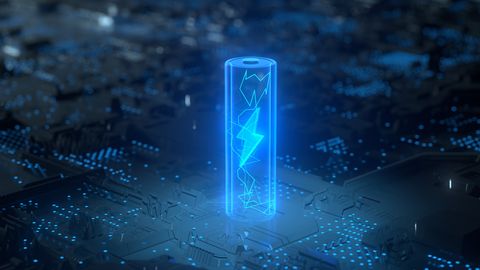“Cooperative” Behavior in Electrolytes Can Significantly Boost Battery Performance
While experimenting with zinc-ion batteries – a new battery type being developed as an alternative to lithium-ion batteries – scientists uncovered a strange phenomenon.

Complete the form below to unlock access to ALL audio articles.
A “cooperative” behavior between complex mixtures in battery electrolytes could provide a new blueprint for future battery design, enabling the wider development of multivalent batteries.
In a new study of zinc-ion batteries, an alternative battery type to the traditional lithium-ion battery present in most commercial devices, researchers at the US Department of Energy’s (DOE) Argonne National Laboratory uncovered a strange phenomenon.
They found that combining two different types of anions with cations in their battery’s non-aqueous electrolyte significantly affected the deposition kinetics of metal on the battery electrodes, improving overall battery performance. The research is published in Chem.
Towards multivalent batteries
Lithium-ion batteries have found extensive use across a range of industries – but they are by no means perfect. For applications such as storing renewable energy on the grid, powering electric buses and other larger-scale operations, additional technologies with larger capacities would be preferred.
Multivalent batteries are one possible solution to this issue. By using elements such as zinc, magnesium and calcium that will have a +2 charge as cations, as opposed to +1 for lithium ions, these batteries can theoretically move more charge and thus store and release more energy.
Multivalent batteries are also attractive from a manufacturing angle, as they tend to use elements that are available in higher abundance than lithium, and that are available through more stable, domestic supply chains.
So, what’s the catch? Today’s multivalent batteries tend to be quite limited in their performance. While their theoretical capacity is high, in reality their ions and electrodes tend to be unstable and degrade quickly. With an electrolyte that is unable to transport cations stably and efficiently, this greatly limits their capabilities.
In order to produce multivalent batteries that are capable of reaching their full potential, scientists need to better understand what is going on within the electrolyte. This means gaining a deeper understanding of how cations interact with other ions and molecules in the electrolyte, especially in more complex electrolyte mixtures.
“We can design better electrolytes by better understanding the mechanisms that drive instability and inefficiency,” said Justin Connell, a materials scientist in Argonne National Laboratory’s Energy Conversion and Storage Group and one of the authors behind the new study.
Mixing different anions can significantly improve zinc-ion battery performance
The Argonne team examined the interactions that occur – and subsequent structures that form – when zinc cations in a zinc-ion battery combined with a mixture of two different anions in an electrolyte.
The researchers constructed a laboratory-scale battery system comprising of a zinc anode and an electrolyte that contained zinc cations and an anion named triflimidate (TFSI), which has a very weak attraction to the cations. This allowed them to study how these interactions affected key battery performance metrics.
The researchers then mixed in chloride ions to the electrolyte, which has a much stronger attraction to zinc cations. The interactions between the various charged particles and the anode were studied using three complimentary techniques: X-ray absorption spectroscopy, Raman spectroscopy and computational modeling using density functional theory.
“These techniques characterize different aspects of the ion interactions and structures,” explained study author Mali Balasubramanian, a physicist and beamline scientist at the Argonne National Laboratory during the study, now a distinguished scientist and lead of the Emerging and Solid-State Batteries Group at Oak Ridge National Laboratory.
“X-ray absorption spectroscopy probes how atoms are arranged in materials at very small scales,” Balasubramanian said. “Raman spectroscopy characterizes the vibrations of the ions, atoms and molecules. We can use the data on atom arrangements and vibrations to determine whether ions are separated or move together in pairs or clusters. Density functional theory can corroborate these characterizations through powerful computation.”
Subscribe to Technology Networks’ daily newsletter, delivering breaking science news straight to your inbox every day.Want more breaking news?
The addition of chloride induced the TFSI anions to pair with the zinc cations. This pairing significantly increased the rate at which the zinc cations were deposited as metal on the negatively charged anode during charging. The same was true when the zinc was subsequently stripped during discharge.
The observed faster reactions at the electrode, which also required less energy to carry out, point to a more efficient conversion of chemical energy into electricity. In practical terms, this means a battery that can charge more quickly and discharge more efficiently.
A new approach to battery design
The research team repeated this experiment but with other anions, bromide ions or iodide ions, being added to the electrolyte mixture. They observed that chloride, bromide and iodide ions were also strongly attracted to the zinc cations, though less strongly than chloride. Similarly, the addition of these anions caused the TFSI anions to pair with the zinc cations, affecting the performance of the battery.
“What was particularly exciting about this result is that we didn’t expect to see what we saw,” said Connell. “The idea that we can use one anion to draw a second anion closer to a cation was very surprising.”
When measuring the electrochemical activity at the interface between the electrolyte and anode, the researchers found that the bromide and iodide were more active than the chloride because they “held” the zinc cations less strongly. This meant that it took less energy to add electrons to the cations, pull zinc metal out of the solution and deposit it on the anode. In other words, this process would cause a battery to charge and discharge more quickly.
“Our observations highlight the value of exploring the use of different anion mixtures in batteries to fine-tune and customize their interactions with cations,” said Connell. “With more precise control of these interactions, battery developers can enhance cation transport, increase electrode stability and activity, and enable faster, more efficient electricity generation and storage.”
The researchers believe that their discovery points towards a new approach for designing electrolytes intended for multivalent batteries. Moving forwards, they want to investigate how other multivalent cations, like magnesium and calcium, interact with different anion mixtures: “Ultimately, we want to learn how to select the optimal combinations of ions to maximize battery performance,” Connell said.
The team also plans to use machine learning to accelerate their selection of the most promising electrolytes and ions.
“Researchers can’t study everything in laboratory experiments,” said lead study author Darren Driscoll, who is now a postdoctoral researcher at Oak Ridge National Laboratory. “There are too many possible combinations of ions to consider and not enough manpower to synthesize them and measure the resulting interactions.”
Lei Cheng, a chemist on the research team and one of the study authors, added, “If a machine learning study were to look at 1,000 different combinations of ions and find 5 promising combinations, an experimental scientist could then take a closer look at those five in the laboratory.”
Reference: Driscoll DM, Lavan SN, Zorko M, et al. Emergent solvation phenomena in non-aqueous electrolytes with multiple anions. Chem. 2023;9(7):1955-1971. doi: 10.1016/j.chempr.2023.03.021
This article is a rework of a press release issued by the Argonne National Laboratory. Material has been edited for length and content.



